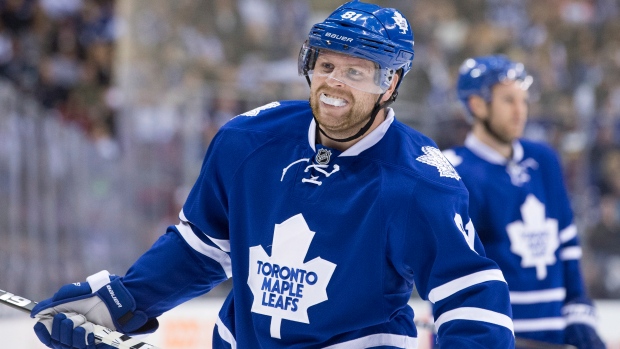Dec 23, 2014
Maple Leafs in the abyss between contender and pretender
The Toronto Maple Leafs are in a state of flux right now. On one hand, we know what this team is – a collection of average or subpar possession players who need to rely on either incredibly hot shooting, incredibly hot goaltending, or a collection of both to win hockey games.
By Travis Yost

The Toronto Maple Leafs are in a state of flux right now. On one hand, we know what this team is – a collection of average or subpar possession players who need to rely on either incredibly hot shooting, incredibly hot goaltending, or a collection of both to win hockey games. On the other hand, I would still consider this a team in the abyss between contender and pretender. They banked a ton of points early in the season, and the bottom of the Eastern Conference doesn’t exactly offer much of a threat.
To Toronto’s credit, they have – this time around, anyway – recognized the team’s fatal flaw. They are consistently and emphatically out-shot on most nights. The organization’s efforts to target a couple of possession drivers this off-season (see Mike Santorelli and Daniel Winnik) have improved the team, marginally, at five-on-five. But, it’s not enough. Not yet, anyway.
While it’s nice to have an improved bottom-six or a couple of decent third-pairing defensemen, most observers of the sport recognize that the team’s most frequently deployed players are going to be the ones creating the wins and losses long-term. Ice time is in direct correlation with game impact, and that’s why your first-liners and first-pairing defensemen are paid the most money.
This is Toronto’s problem. The first-line is routinely caved in, and when the goals dry up, they certainly look the part of one of the worst top trios in the National Hockey League.
To illustrate this, I graphed out the performance of each team’s first-line to start the year using RelativeCorsi% (team difference in Corsi% when a player is on the ice versus off) and RelativeGoal% (team difference in Goal% when a player is on the ice versus off). For Toronto, that’s the Bozak line (though I do note that the coaching staff has really started to give bigger minutes recently to the Kadri group).
Let’s take a look at all thirty teams:

It makes intuitive sense that first-line talent should out-perform second, third, and fourth-line talent on the same team. Look at the horizontal axis divide (“RelativeCorsi%”) and note how basically every team is better off with the first line on the ice than off. Only Florida, Buffalo, Arizona, and Toronto have first-lines generating unfavorable possession relative to their teammates. Of course, Buffalo and Florida’s first-lines are at least generating favorable goal differentials relative to the team average, and Arizona’s within the realm of break-even.
Toronto’s top-line has been territorially bludgeoned all season long and, sometimes, it’s hard to explain why. Phil Kessel is generally regarded as one of the league’s elite wingers, and it’s not as if James van Riemsdyk – who scored 30-goals one season ago – grades low on talent. This year, primarily due to an improvement in Toronto’s depth forwards, the front-line has been relatively more exposed – when the first-line comes off, Toronto’s possession significantly improves. And when the first line gets back on, possession significantly declines.
The problem, as you might guess, comes on the defensive side of the game. It was the problem when Bozak and Kessel were united back in 2009-2010, and it’s progressively worsened even with the addition of van Riemsdyk on the wing. To show the line’s defensive woes, we can look at how teams have been able to generate shot-attempts against this trio over the years. For record, the average forward is on ice for about 55 shot-attempts against per 60 – we’ll use this as break-even in the graph below.

I have long recognized that Kessel, Bozak, and van Riemsdyk likely possess slightly above-average shooting skill relative to the league norm, but I don’t think it’s nearly enough to offset how dreadful they are from a territorial aspect. Even if you subscribe to the theory that Randy Carlyle’s responsible for a collective possession drag, it’s not really a justification for how awful this group is defensively – for five years (and counting), their less-talented teammates have managed to perform significantly better in limiting shot-attempts against.
I’m not sure what the coaching staff or front office does in the short-term – this is the roster that has been assembled, and aside from re-assembling the top-six to more prominently feature Nazem Kadri (which has been tried in the past), there’s not a whole lot you really can do other than hope and pray for another percentage-fueled run.
But, I do think the data on this group is clear. There’s something of a hard cap on the shooting talent this group possesses, and because of that, it’ll never be enough long-term to offset just how appalling they are defensively. Further, based on the team’s logical and obvious commitment to star winger Phil Kessel, you can rest assured that the primary objective over the next year or two will be to hope for one of their young centre prospects to continue pushing into a top-six role, or send a collection of assets to another team to get that coveted first-line centre.

